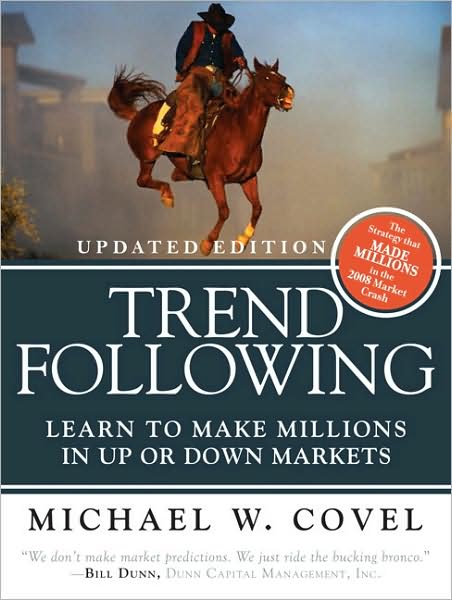Book Review: Trend Following (4)
While reading the book Trend Following, I was reminded of something that I read in The Intelligent Investor (I have the Fourth Revised Edition.)? These are two very different books.? What could be the same?
Fortunately, you don’t have to have a copy of The Intelligent Investor to see this.? Appendix 1 of the book is, the edited transcript of Warren Buffett’s talk that he gave at Columbia University in 1984 for the 50th anniversary of publication of Security Analysis can be found here.? The PDF version can be found here — it has the tables, but will take a while to load.
Buffett chooses 9 investors in the mold of Ben Graham, all value investors, and shows how they have soundly trounced the market over their tenures.? He uses that correlation to demonstrate that since they all used the same basic theory of investing, it is unlikely that their wonderful performance is due to mere chance.
In appendix B of his book, Michael Covel chooses 14 (or so) investors who are trend followers, and shows how they have soundly trounced the market over their tenures.? He uses that correlation to demonstrate that since they all used the same basic theory of investing, it is unlikely that their wonderful performance is due to mere chance.
See the similarity?? Now, I think that both approaches work to some degree, though not all of the time.? I have known a number of managers that have married the two approaches, usually with some success.? (As Humble Student Cam Hui points out, marrying the two may be more difficult than it seems.? I’m going to have to dig up that copy of the Financial Analysts Journal.)
I would criticize one aspect of Buffett’s logic, and the same would apply to Covel.? I’ve known my share of bad value investors.? Usually they overemphasize cheapness, and forget “margin of safety” as the key intellectual concept of value investing.? It’s easy to come up with a group of great managers following a certain strategy in hindsight.? Where is the grand study of all investors of that class, be it value investing or trend following?? Almost any strategy could be made to look good if one can cherry-pick the investors with the advantage of hindsight.
So, what would qualify as a valid study?? You’d need a relatively complete census of the group following a given strategy, including those that failed and dropped out.? After that, audited returns would help, as Mr. Covel likes to point out.? An alternative would be to follow a smaller closed cohort of managers following a certain management style.? The problem with that is you yourself might have a really good eye for management talent apart from the investment style.
Another alternative would be an academic-style study where the researcher defines the buy and sell criteria and then sees if the method beats the market, whether adjusted for risk or not.? Now, regarding risk, that is one of many places where I agree with Mr. Covel.? Standard deviation does not measure it; beta doesn’t measure it; tracking error doesn’t measure it.? Maximum drawdown, or maybe some obscure statistic from extreme value theory would probably be the best measure.
Why drawdown?? It best measures the ability of a manager to continue his strategy without panicking.? Most of us would question our sanity after a certain level of loss, and give up.? For different investors, the number is different.? For those managing external money, it is more important, because normal investing processes get destroyed when investors pull their money.? Where is that maximum level where investors will stay on board?? It depends on how they were sold on investing their money with the manager.
What are the problems with doing an academic-style study?
- Often does not include costs of commisions, market impact, etc.? Liquidity is implicitly free, while in the real world, it is costly, particularly for undervalued oddball securities.
- Data-mining may allow anomalous result that are noise to be reported as signal.
- Managers using the style being modeled argue that it does not truly represent what they do.
- Some studies get skewed by using calendar-year-end dates, where trading is often unusual.
Does that mean doing? definitive studies of trading strategies is impossible?? No, but it is quite expensive to do, so those interested in questions like this often resort to shortcuts, such as academic studies, limited peer group studies, etc.
Now, fairly comprehensive studies for things like growth and value managers exist (tsst… value wins), and some studies for CTAs exist.? But I’m not aware of any comprehensive studies for trend followers.? The academic studies show that price momentum is an important factor in market returns, and many investors with good returns use momentum.
It begs the question, if price momentum, or trend following is a panacea, why is it not more broadly embraced by the money management community?? That is tomorrow’s essay.


